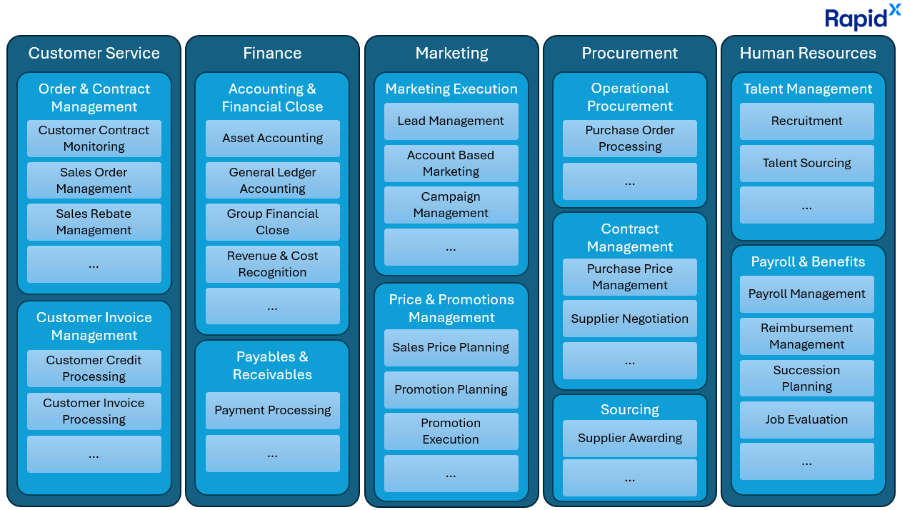Where Should You Focus Your Transformation Efforts?
One of the most common questions at the start of an SAP S/4HANA transformation journey is:
“How do we know where to focus our efforts for the greatest value?”
There are multiple approaches that can assist in answering this question (including automated toolset based approaches such as the SAP Readiness Check and Signavio Discovery Edition, but a technique that we strongly recommend during our structured transformation preparation phase (known in the SAP world as ‘Phase Zero’) is Business Capability Modelling (BCM). By mapping what your business must be capable of - and then assessing how well those capabilities perform today - you gain a structured way to identify:
- Where transformation will deliver the most value
- Where existing capabilities are weak, outdated, or inefficient
- Where to prioritise investments
It is a great way to involve business stakeholders early-on during the preparation phase, since this is a non-technical, business centred approach to defining what is important.
What is Business Capability Modelling?
A Business Capability Model is a visual map of the essential things your organisation must be able to do to succeed. It captures “what” the business does, rather than focusing on “how” (processes) and expresses this in a language that is meaningful to all, helping to break down those barriers that we often see between IT and the business communities.
Examples of core capabilities may include:
- Sales
- Customer Service
- Finance
- Sustainability Management
Everyone can easily understand these terms, making it much easier for all stakeholders to work together to determine the core capabilities of the business and, importantly, what it must do in the future to achieve the overall business strategy.
…And, unlike Org Charts or Process Maps, once they have been defined, Business Capability Models are fairly stable over time. Only shifts in Business Strategy should result in the need for updates (e.g. entry into new markets).

How does a Business Capability Model help during transformation planning (Phase Zero)?
During the preparation phase of an SAP transformation, a Business Capability Model serves several purposes in helping frame and scope your project:
- Target Value Delivery – Highlights capabilities that most impact business outcomes (e.g., customer experience, cost efficiency).
- Input to Business Case – Identifies where modernisation could generate measurable value, strengthening investment justification.
- Fit-to-Standard Preparation – Reveals those capabilities that are immature/sub-optimal (or even new) and therefore should be reimagined rather than replicated in SAP S/4HANA.
- Scope Alignment with System Integrators – Allows clear definition of which capabilities are in scope for your SI to deliver as part of the transformation programme.
- Prioritisation & Risk Management – Helps apply focus to your differentiating capabilities, while managing commodity (e.g. back-office) areas more pragmatically.
This helps you to ensure transformation efforts are directed where it matters most i.e. where you will deliver the most value.
How to Create a Business Capability Model
Creating a BCM doesn’t need to be complex. The key is to start pragmatic, focus on value, and avoid over-engineering.
1. Engage Business and IT Together
Co-create your BCM with business leaders/Process Owners - don’t let it be an IT-only exercise. Use BCM workshops as a chance to align on strategy and execution.
2. Start Simple
Begin with 7 to 10 top-level capabilities at Level 1, this should be sufficient to visualise your entire organisation. Each Level 1 capability should be mutually exclusive and not overlap; this allows a Level 2 item to be assigned without significant discussion). Expand into Level 2 and go no deeper than level 3 to avoid drowning in detail. This 3-level model will be more than sufficient for IT to map the application landscape in a later stage.
3. Define “What”, Not “How”
Capabilities describe what you do (e.g. “Manage Suppliers”), not how you do it (the process steps).
4. Prioritise Future-State First
Focus on future-state or sub-optimal capabilities that align with your transformation vision. A complete current-state analysis has value but shouldn’t dominate your BCM efforts during Phase Zero.
5. Link to Technology
Once the capabilities are mapped and agreed, IT can map applications to the model to uncover gaps, overlaps, and risks (e.g. end of life platforms). This helps show where modernisation efforts should focus.
6. Use Heatmaps to Show Maturity and Risk
Once defined, you can apply a ‘heatmap’ view to each of the capabilities to give an easy-to-read visual indication of where transformation effort is required:
- Red = Poor performance / high risk
- Amber = Moderate fit
- Green = Strong capability
Best Practices and Common Pitfalls when creating a Business Capability Model
Here are some simple Do’s and Don’ts to help accelerate the creation of your BCM during Phase Zero:
Do’s
- Involve senior stakeholders early to ensure buy-in
- Keep capabilities business-focused, not IT jargon
- Use BCMs as a storytelling tool to align execs and SIs
- Continuously refine the model as your strategy evolves
Don’ts
- Don’t rely solely on generic templates (they limit thinking)
- Don’t confuse capabilities with processes or org structures
- Don’t overcomplicate - BCMs are a guide, not a full operating manual
To help support your BCM efforts, you can use our sample download, but remember this is to start the conversation. No two BCM’s are the same…
Conclusion
Significant application upgrades, such as a move from SAP ECC to SAP S/4HANA, represent a significant opportunity to improve the current way your business operates. To make the most of this opportunity, it’s important to understand the question isn’t just “How do we upgrade?”, it’s “Where should we transform?”
By using Business Capability Models, you gain a structured, visual, and strategic way to identify transformation opportunities, build a compelling business case, and ensure your SAP S/4HANA journey focuses on the areas of highest impact.
.png?width=165&height=71&name=output-onlinepngtools%20(1).png)
.png?width=168&height=71&name=output-onlinepngtools%20(3).png)
